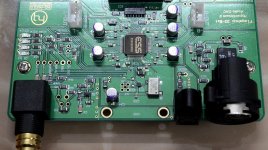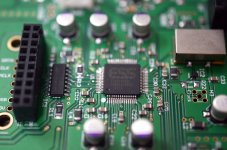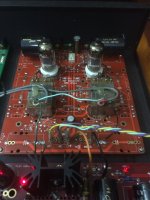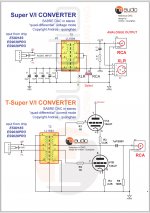super I/v output
I prefer WE396A in this configuration I agree this topology has a super sound i used this as a driver for a SE tube , and since then convinced that driving SE tubes best done with PP driver.
And no need for such large output caps , if you are driving an input pot of 50K 0,47µF to max 1µF will do ( use Rl 100K or higher ), size a bit better from Duelund and same magic .
For those who are interested I have enough of these original WE tubes and can supply Duelund at good price , As for the powersupply maybe separate e chokes per channel seems best as all the effort of the dac should be kept.
I'll design a pcb for this next week , getting very curious
I prefer WE396A in this configuration I agree this topology has a super sound i used this as a driver for a SE tube , and since then convinced that driving SE tubes best done with PP driver.
And no need for such large output caps , if you are driving an input pot of 50K 0,47µF to max 1µF will do ( use Rl 100K or higher ), size a bit better from Duelund and same magic .
For those who are interested I have enough of these original WE tubes and can supply Duelund at good price , As for the powersupply maybe separate e chokes per channel seems best as all the effort of the dac should be kept.
I'll design a pcb for this next week , getting very curious
Ok, now. New IV
I have tried to test a lot of IV for ES9038.
I am trying hard to spot an I/V in your circuit. Is it hidden inside the Duelund caps?
I am trying hard to spot an I/V in your circuit. Is it hidden inside the Duelund caps?
No, it does not depend on Duelund ,
Because I have more available Duelund receptors.
Just a good capacitor, you will see good results!
thanks
I prefer WE396A in this configuration I agree this topology has a super sound i used this as a driver for a SE tube , and since then convinced that driving SE tubes best done with PP driver.
And no need for such large output caps , if you are driving an input pot of 50K 0,47µF to max 1µF will do ( use Rl 100K or higher ), size a bit better from Duelund and same magic .
For those who are interested I have enough of these original WE tubes and can supply Duelund at good price , As for the powersupply maybe separate e chokes per channel seems best as all the effort of the dac should be kept.
I'll design a pcb for this next week , getting very curious
Nice , looking forward
Last edited:
I am trying hard to spot an I/V in your circuit. Is it hidden inside the Duelund caps?
I think the I to V was done by the primary coil of the LL1684.
Hi Quanghao,
this is to report that we have successfully (well, my friend smanz indeed) tested your dac with a pair of your lundahl boards and their corresponding trafos.
The test was made comparing that setup against a buffalo DAC with a super modded IVY output stage (best quality in capacitors and resistors that you can imagine). No blind test, just a simple listening session over a couple of songs that we know well.
The result was, and we both agree on that front, that your DAC is much better in every single corner. Better timbre, better sound stage, very well articulated and capable of showing all nuances with a big orchesta, and in summary... a better DAC. I find it very musical and dynamic.
We (my friend and I) disagreed nevertheless on how voices are presented. In my opinion, the ES9038 is darker .... maybe the trafos ? maybe the filter we used (brickwall) ?. Now we have a battery for the remote, we will make the test again (perhaps with an apodizing filter?) but for this occasion we´ll use a bigger contender: quadruple Buffalo ES9018 DAC with tubes output stage.
I will get back here with our conclusions. In any case, thank you and congratulations for the DAC. It is a great product, no question about it.
Cheers
Pepe
IMHO, Ivy output stage is really inappropriately low quality in relation to Buffalo SQ. No suprise any decent 9018/38 dac using good output transformers performs much better...
It would be interesting to compare Quanghao's 9038 dac and Buffalo using the same transformers or tubes output stage: that test would really show how much better the 1st is...
Yesterday, Pepe, another two friends and my self, we had a comparative session between Buffalo doble mono and HQ ES9038.
In one corner, Buffalo doble mono with the better output stage we had listened at the moment. Better than transformers output. The Raleigh Audio Line Stage clone. Is a Differential parafeed line stage push-pull with a pair of CCS (constant current source) to isolate the power supply from the signal. ES9018 USB DAC - Hi-Resolution System
In the other corner, HQ ES9038 with transformers output stage.
All of us, give clearly winner to HQ ES9038.
Regards
In one corner, Buffalo doble mono with the better output stage we had listened at the moment. Better than transformers output. The Raleigh Audio Line Stage clone. Is a Differential parafeed line stage push-pull with a pair of CCS (constant current source) to isolate the power supply from the signal. ES9018 USB DAC - Hi-Resolution System
In the other corner, HQ ES9038 with transformers output stage.
All of us, give clearly winner to HQ ES9038.
Regards
IMHO, Ivy output stage is really inappropriately low quality in relation to Buffalo SQ. No suprise any decent 9018/38 dac using good output transformers performs much better...
It would be interesting to compare Quanghao's 9038 dac and Buffalo using the same transformers or tubes output stage: that test would really show how much better the 1st is...
agreed Luca, that is why we tried as harder as we could on this experiment. Smanz has already summarized the result. The distance is so big that it does not matter what you put at the output of the ES9018.
cheers
Pepe
agreed Luca, that is why we tried as harder as we could on this experiment. Smanz has already summarized the result. The distance is so big that it does not matter what you put at the output of the ES9018.
cheers
Pepe
Really? That sounds very neat in favour of 9038 DAC...
My 9038 is just thrown together bolted to a piece of wood, wires too long and not dressed, using just the Lundahl LL1684, no filters. Being fed i2s from Rpi with Allo Kali re-clocker, streaming from Roon.
Its been running 24/7 since delivery and the output is just sublime. by far and away the best DAC that I have listened to. I'm currently only listening through an OTL headphone amp, can't wait to box it up and get it in my main rig.
Its been running 24/7 since delivery and the output is just sublime. by far and away the best DAC that I have listened to. I'm currently only listening through an OTL headphone amp, can't wait to box it up and get it in my main rig.
Compare : ES9018S, ES9028PRO, ES9038PRO
Me and many of my friends have compared 3 chips
1. On the same IV (LL1684 + 12AU7),
2. On a system: speakers, amplifiers, wires.
3. On a DAC board-my design.
4. Different chips: ES9018S, ES9028PRO, ES9038PRO
The following results:
With mode: Current Output: ES9038PRO = 2 times ES9028PRO, = 3 times ES9018S.
Sound is very different.
The ES9028PRO is better than the ES9018S, and the ES9038PRO is better than the 9028PRO in terms of dynamics, and acoustics.
The ES9028PRO sounds quieter and sweeter than the ES9038PRO.
Please compare, if possible!
Thank you so much!
Quanghao
Me and many of my friends have compared 3 chips
1. On the same IV (LL1684 + 12AU7),
2. On a system: speakers, amplifiers, wires.
3. On a DAC board-my design.
4. Different chips: ES9018S, ES9028PRO, ES9038PRO
The following results:
With mode: Current Output: ES9038PRO = 2 times ES9028PRO, = 3 times ES9018S.
Sound is very different.
The ES9028PRO is better than the ES9018S, and the ES9038PRO is better than the 9028PRO in terms of dynamics, and acoustics.
The ES9028PRO sounds quieter and sweeter than the ES9038PRO.
Please compare, if possible!
Thank you so much!
Quanghao
Attachments
Hi all!
I have new open GR2:
http://www.diyaudio.com/forums/group-buys/306118-dac-es9038-pro-gr-2-a.html#post5039634
I always look forward to receiving your help!
Thanks a lot!
I have new open GR2:
http://www.diyaudio.com/forums/group-buys/306118-dac-es9038-pro-gr-2-a.html#post5039634
I always look forward to receiving your help!
Thanks a lot!
Hi Quanhao!
Looking the user manual... in the blocks diagram, why it says "Voltage output"?. Can't I use the DAC in current output and use a traditional I/V output stage?
Thank you!
Regards,
Ignacio
you can use R iv for current output.!
thanks
I think the I to V was done by the primary coil of the LL1684.
This does not make any sense.
All the circuits in this thread seem to employ the voltage mode. Nothing wrong with this of course, only that it is nonsense to put labels as I/V or V/I when all they do is V/V.
Quanghao proposes two output configuration.
The top one is 'Voltage' mode with only the LL1684 as a passive output device. The '+' and '-' output from the DAC is connected to the '+' and '-' of the primary of the output transformer. The mid point of this connection is connected to the ground by a 10K resistor. There is no way 'current' to run to the ground due to this resistor. Thus a voltage mode.
The bottom one is 'current mode'. Instead of a 10K resistor, the coil is connected directly to the ground instead. Each coil (of the LL1684) has a resistance of 41 ohm. Thus the output of the DAC will force current through the coil to the ground. Thus the coil is also acting like a resistor and performs an I-V.
Attachments
Last edited:
- Home
- Group Buys
- DAC ES9038 PRO Group Buys



